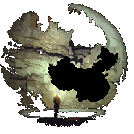
Grottes et karsts de Chine
Sur les traces de Xu Xiake
Gebihe 89 Contents
FOREWORD
After the successful expedition "GUIZHOU EXPE 86", the speleo-club PSCJA of Vénissieux and the Institute of Geology of the Academia Sinica decided to continue their collaboration. Following a reconnaissance in 1988 by three members of the French team and a visit to France by Prof. Zhang Shouyue in 1989, it was decided to organise the second expedition "GEBIHE 89".
The team consisted of seven Chinese scientists, 13 European cavers and scientists (11 French, 1 Belgian, 1 German) and a cameraman. It was decided to work in eight counties of three provinces: Central and South Guizhou (counties of Zhijin, Ziyun and Pingtang), the extreme east of Sichuan (Wuxi) and the southwest of Hubei (Wufeng, Hefeng, Lichuan and Yichang). To reach the different areas, altogether 6000 kilometres were travelled by train, bus and boat.
Between 22nd October and 20th December 57 km of cave passages were surveyed in 50 different caves. The results matched the extraordinary greatness of the Chinese karst. In the cave system of Gebihe (-445 m) in the county of Ziyun (Guizhou) the "Chamber of the Miaos" was found, the largest underground room in China and the second largest in the world after "Sarawak Chamber" (Mulu / Malaysia). In the county of Wufeng (Hubei) the remarkable alpine system of Dongxitiankeng (5 km, -382 m) was explored and for the first time in China gypsum speleothems were discovered in the cave system of Longdong-Yanzidong.
In the course of scientific field studies a large number of water samples were taken for chemical and bacteriological analysis. An amazing series of sedimentary cave deposits, 25 m high, were studied in situ in Dadong (Wufeng, Hubei).To carry out detailed laboratory studies (datations, thin-sections, chemical analysis etc.) more than 100 kg of rock-samples were collected .
In September 1990, three Chinese scientists came to France to work on this report and to help analysing the water samples in the laboratory of the Faculty of Science at Avignon. We also took the opportunity to take our visitors to some French karst areas, such as the Vaucluse fountain, the Chartreuse and the Vercors area.
This expedition report is the outcome of an enormous amount of work carried out by two teams inspired by their mutual passion of discovery. And if you would like to take part in the adventure which resulted from this passion, just read on and follow us into the the heart of the fabulous Chinese karst.
Jean-Pierre BARBARY - ZHANG Shouyue